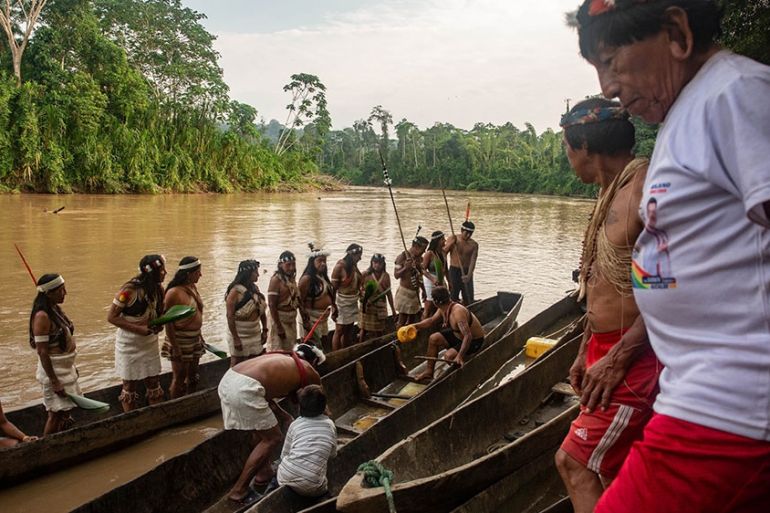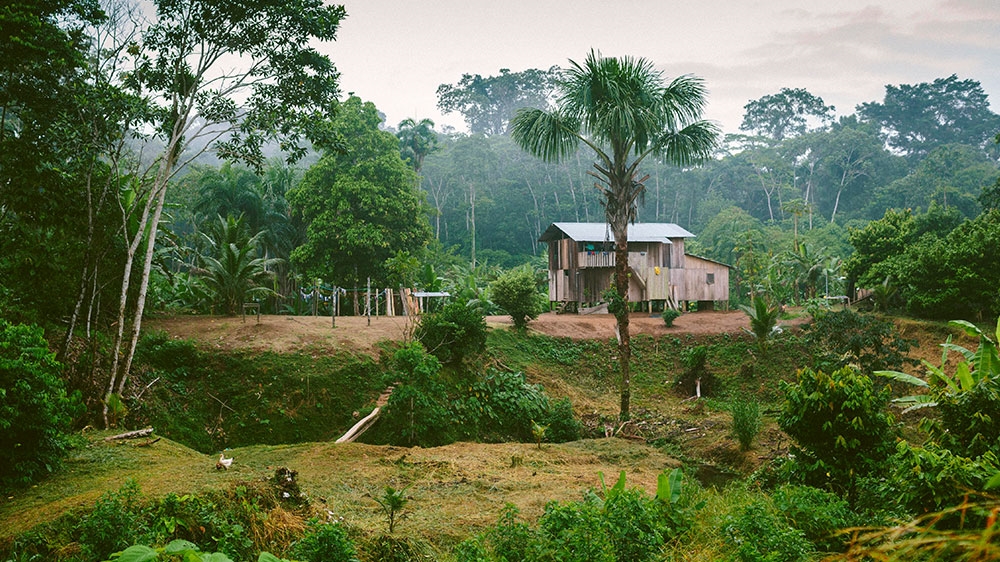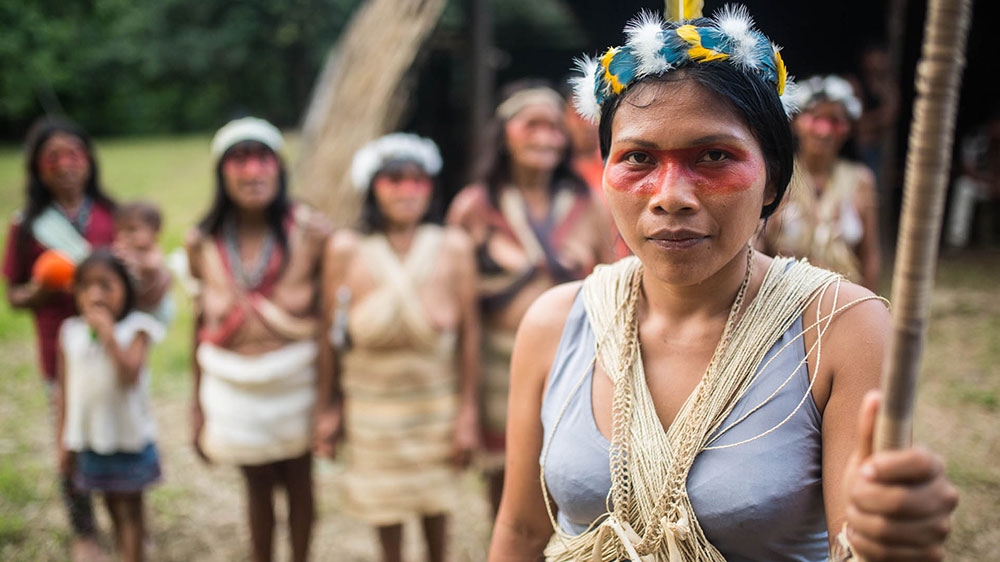Indigenous race into Ecuador’s Amazon to escape coronavirus
Fearing repeat of history, Indigenous groups in Ecuador rush back to their territories in an attempt to escape COVID-19.

Quito, Ecuador – Nemonte Nenquimo, an Indigenous Waorani leader from Ecuador’s Amazon rainforest, watched as her Indigenous colleagues, family and friends rushed back to their territory this past week, attempting to escape the threat of the coronavirus engulfing the region. Some travelled by car or bus, others flew by charter plane or travelled by boat upriver, deep into the rainforest where there are no roads.
Nenquimo stayed behind in the town of Shell, saying she has travelled too much, spoken to too many people and kissed too many cheeks over the past few weeks. It would be too risky to go back to her community now; if she were a silent carrier of COVID-19, it could be devastating to the Indigenous population there.
Keep reading
list of 3 itemsYour coronavirus emergency kit: Five workouts to do at home
Trump, despite virus warnings, wants US back at work by April 12
“We haven’t heard of any cases in the communities yet, that’s why it’s better to take care and protect them,” says Nenquimo, leader of the Coordinating Council of the Waorani Nationality of Ecuador Pastaza (CONCONAWEP).
“Now, it’s all under control, nobody can enter or leave the territories,” she adds.
Last week, the Confederation of Indigenous Nationalities of the Ecuadorian Amazon (CONFENIAE) closed all access to the rainforest, denying entrance to both tourists and Ecuadorian nationals. They also demanded that all oil, mining, hydroelectric and logging companies that operate in the rainforest stop rotating their personnel and bringing people in from the cities, and suspend all activities near communities, says CONFENIAE President Marlon Vargas.

If contagion reaches the Indigenous territory, “it would be an extermination of the Indigenous population of the Amazon basin,” says Vargas. This would include the 11 nationalities, over 500,000 Indigenous peoples, who currently live in Ecuador’s Amazon, he adds.
The Indigenous population grew more concerned after two cases of the coronavirus were confirmed in the Amazon region last week.
The first was in the northern province of Succumbios. A tourist travelling in the Cuyabeno nature reserve there tested positive for COVID-19. The other was identified in the southern province of Morona Santiago, where a resident of the city of Gualaquiza contracted the virus after their partner returned from Spain. Both patients were immediately quarantined, yet numbers in both provinces have since increased to six cases each.
Currently, there are more than 1,082 cases of COVID-19 confirmed in Ecuador as of Tuesday, according to state figures. At least 27 people have died as a result of the virus. The vast majority of cases are in the coastal province of Guayas, where the largest city in the country, Guayaquil, is located.
Last week, the government declared a national state of emergency, ordering everyone to stay home unless they were buying food, medicine or going to work. Those who defy the order could face a fine of up to $6,000 or three years in prison. The government has also closed borders, cancelled all in and outbound international flights, prohibited national travel and implemented a strict nationwide 2pm curfew.
CONFENIAE translated these regulations and other preventive measures into various Indigenous languages. The social media hashtag #StayAtHome, was also translated to Kichwa and Shuar, #WasipiSakiri and #JeminPujusta respectively, to reach as many people as possible.
Repeat of history?
Vargas says communities are rightfully nervous, and recalls past illnesses like yellow fever, cholera and the H1N1 virus that caused similar alarm. Some estimate that, by the early 17th century, as much as 90 percent of the Indigenous population in the Americas was wiped out by the flu and measles, among other diseases, brought by Europeans.
Erika Arteaga Cruz, specialist in global and community health with the Latin American Association of Social Medicine (ALAMES) and the People’s Health Movement, says there’s no proof that Indigenous communities are more prone to the COVID-19 virus than the rest of the population, as everyone is simultaneously being exposed to it for the first time. But their social conditions do make them more vulnerable to contagion.
The Amazon lifestyle often does not include the use of soap, hand-sanitiser or clean water in some areas, but the bigger risk is their remote location and lack of access to hospitals, doctors and medicine, says Arteaga.
In Nenquimo’s case, the closest hospital to her community of Nemonpare is in the Amazon city of Puyo, which is at least 30 minutes away by charter plane, or an eight-hour ride downriver to the nearest port.

Andres Guncay, epidemiologist responsible for public health surveillance in the provinces of Morona Santiago, Canar and Azuay, says Indigenous communities are more at risk with the coronavirus because many of them suffer from malnutrition. This could compromise their immune system and how well they are able to combat the virus if they do get it, he says.
Nenquimo says she is most concerned for the elder populations, also known as “pikenanis” in Waorani, who are extremely important for the community and maintaining their culture.
“This is a virus that is killing elders around the world, and that worries me. For us, our elders are the wise ones, the authorities, the ones that guide us” she says.
But Guncay says if COVID-19 makes it into the community, the risk would “be a lot more severe”. Many live in the humid jungle in open homes with no walls, or share a bedroom with the entire family, making social distancing next to impossible, and spread would be difficult to contain.
In a news conference last week, Ecuador’s National Secretary of Risk Management, Alexandra Ocles, said there would be no special security protocols for Indigenous populations in regards to COVID-19. Rather, they are expected to abide by the national state of emergency standards, saying, “It is also their responsibility to comply.”
But the strict stay at home measures will be hard for some. Heavy rains have caused several rivers to overflow in the central Amazon that washed away homes, community crops, potable water systems and solar panels from the Indigenous Kichwa territories of Sarayaku and Papayaku, and surrounding communities.
We have been the fighters and protectors of nature, but people keep taking advantage and wanting to destroy it. That's where illnesses come from, that's where climate change comes from. I'm very worried; I see the world is not waking up.
Patricia Gualinga, Kichwa leader and resident of Sarayaku, says up to 3,000 people have been affected, many of whom had just returned to their territory to escape the coronavirus in the cities.
“They’re going to do what they can to survive out there,” says Gualinga, who was in Puyo during the floods. “They can’t come back, everything is restricted,” and they don’t have the economic resources to stock up on groceries and live indoors for an extended period of time, she says.
If people do not change their habits of destroying and taking advantage of nature, worse floods, illnesses, and pandemics are bound to happen, says Vargas.
“Now, is a time to reflect and act,” he adds.
Nenquimo agrees. For centuries, the Indigenous people lived well in the rainforest, they protected nature and stayed healthy, and it is time people start listening to their struggle, she says.
“We have been the fighters and protectors of nature, but people keep taking advantage and wanting to destroy it. That’s where illnesses come from, that’s where climate change comes from,” says Nenquimo, adding, “I’m very worried; I see the world is not waking up.”